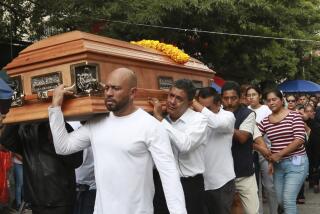Reality Gap of Our Nicaragua Policy : Administration Efforts to ‘Remove’ Sandinistas Are Flawed
- Share via
Retired Gen. Paul F. Gorman, who until recently was commander of U.S. military forces in Central America, supports the military pressures brought to bear on Nicaragua and favors continued U.S. help to contra guerrillas fighting to overthrow the Marxist-dominated Sandinista regime.
Yet, in testimony before a Senate committee a few weeks ago, the general warned that the Nicaraguan rebels are incapable of overthrowing the leftist government with or without U.S. help. In his words, “I would argue that you build your policy on what’s possible.”
Gorman’s testimony is worth recalling, because it is abundantly clear that the Reagan Administration’s policy in Nicaragua suffers from a reality gap.
The policy goal is to “remove” the present government from power--or, as President Reagan himself has described it, to force the Marxist-Leninist leaders of the Sandinistas to “say uncle.” The problem is the disconnection between the goal and the means being relied on to achieve it.
The Sandinistas are not going to leave office willingly. The Reagan Administration has no intention of using U.S. troops to throw them out. Instead, it is relying on the contras to produce a situation in which anti-Sandinista forces will be able to take over and establish a democratic regime.
There is a fundamental question as to whether the United States should be in the business of promoting the overthrow of another government. The Administration uses two justifications:
--The danger that Nicaragua poses to its neighbors, and therefore to U.S. security interests in the area, because of its political and military ties to Cuba and the Soviet Union, and the Sandinistas’ ideological commitment to spreading their creed. The concern is legitimate.
--The determination to free the Nicaraguan people from an incipient communist totalitarianism. This is a much more dubious and difficult enterprise. However, the right of anti-Sandinista Nicaraguans themselves to engage in armed revolution (and to seek outside help for their efforts) cannot fairly be challenged.
The Sandinistas’ own claim to represent the Nicaraguan people is really based not on the outcome of the elections last November, in which opposition parties were not given a fair chance to compete, but on their supposed leadership of the armed overthrow of the hated right-wing Somoza regime in 1979.
In real life the anti-Somoza struggle was not a Sandinista monopoly; it included leaders of the Roman Catholic Church, important elements of the business community and democratic-minded politicians. The anti-Somoza forces got outside help not just from Cuba but also from Costa Rica, Panama and Mexico.
The Sandinista junta then promised to install a democratic government by vote of the people. An election of sorts was held last year. The Nicaraguan economy still has sizable pockets of private enterprise, and individual free speech is tolerated up to a point. But the nine-man Sandinista directorate, which runs the country, is dominated by a group determined to install a Cuban-style Marxist-Leninist system, and is well on the road to doing it.
Press censorship is pervasive. The Catholic Church is under attack. Cuban-style block committees are on the alert for “counter-revolutionary” elements. Schoolchildren are being taught the glories of “socialism” and the evils of “imperialism”--which, by Sandinista definition, is anybody who opposes the leftist regime.
Washington’s disillusionment with the Sandinista-led government’s anti-democratic tendencies and its close ties with Cuba and the Soviet Bloc began while President Jimmy Carter was still in office.
The Reagan Administration, with the acquiescence of Nicaragua’s worried neighbors, went from disillusionment to active sponsorship of an anti-Sandinista civil war and frequent maneuvers in and around neighboring Honduras.
These military pressures have had an effect. The Sandinistas are too busy fighting the contras to give much help to the Marxist guerrillas in El Salvador. The economy is a shambles. This, plus military conscription, is feeding public dissatisfaction with the regime.
Most important, the civil war has greatly increased the interest of the worried Sandinista leaders in a negotiated solution of their differences with the United States.
In direct talks with U.S. representatives and with the Contadora group, the Sandinistas have agreed to refrain from supporting insurrections against neighboring countries, to reduce the size of the Nicaraguan armed forces and to negotiate a withdrawal of military advisers from the area, whether they be Cuban or American.
Washington argues that the Sandinista concessions are less real than they seem, that too many loopholes remain. If so, that is a proper subject for further negotiations. But Reagan’s bottom-line demand--that Nicaragua’s internal political arrangements be made subject to negotiation--is flatly rejected by the Sandinistas.
Although no one can be sure, a policy aimed at using a combination of military pressures and stepped-up economic sanctions might force the Sandinistas to make grudging but real concessions to the democratic opposition, thereby fending off completion of the Marxist revolution and containing whatever threat Nicaragua poses to its neighbors.
But Reagan’s demand for abject surrender is not going to work. Nor, as Gorman warned, is it much more realistic to believe that the contras, even with U.S. aid, can trigger a mass anti-Sandinista uprising.
Nicaragua isn’t Cuba or Poland. The Soviet army is far away, and none of the Sandinista leaders have the personal popularity of a Fidel Castro. But they control the army and the security police, and will not be easily dislodged.
By holding out for what is probably impossible, Reagan is fatally undermining public and congressional support for his cause--without getting rid of the troublesome Marxist-Leninists in Managua.
More to Read
Sign up for Essential California
The most important California stories and recommendations in your inbox every morning.
You may occasionally receive promotional content from the Los Angeles Times.













